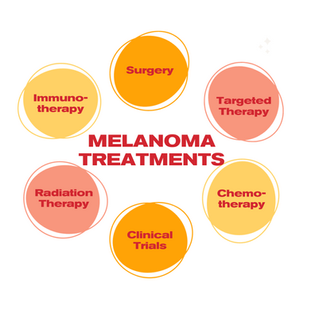
Understanding Melanoma Treatment Side Effects
Facing a melanoma diagnosis can be a daunting experience. Thankfully, there are various treatment options available to combat this disease. These treatments offer the potential for recovery and a return to a fulfilling life. It’s important to be aware that, like any medical treatment, melanoma treatments can come with side effects. In this blog post, we’ll explore the side effects associated with the most common treatment types, providing insights that can empower patients to navigate their melanoma treatment journey with confidence.

Immunotherapy Side Effects
Immunotherapy is a treatment that harnesses the body’s immune system to fight cancer cells. As with any treatment, side effects can vary from person to person. They also vary depending on the type of immunotherapy drug. The Canadian Cancer Society lists the following symptoms:
The side effects of Interferon alfa-2b or interleukin-2 (cytokines) for melanoma may include:
Flu-like symptoms: Patients may experience symptoms such as fever, chills, and body aches, reminiscent of the flu.
Fatigue: General tiredness is a common side effect.
Loss of appetite: Anorexia, or loss of appetite, may occur.
Digestive issues: Side effects like diarrhea and nausea/vomiting can affect some patients.
Skin problems: A rash may develop as a side effect.
Low blood cell counts: Some patients may experience a decrease in blood cell counts.
Depression: High-dose interferon alfa-2b may lead to depression.
Swelling: Interleukin-2 can lead to swelling due to fluid retention.
The side effects for ipilimumab, nivolumab or pembrolizumab (immune checkpoint inhibitors) may include:
Fatigue: Patients may experience increased tiredness.
Diarrhea: Digestive issues, including diarrhea, can occur.
Skin problems: Some individuals may develop a rash.
Headaches: Headaches may be a side effect.
Liver problems: Yellowing of the skin and eyes may indicate liver problems.
Thyroid problems: Changes in weight, body temperature, heart rate, and blood pressure may result from thyroid issues.
Lung problems: Cough and difficulty breathing can be side effects.
It’s important to note that side effects can occur at any time during or after immunotherapy. While most side effects are temporary and can be managed, some may persist over the long term. It is crucial for patients to report any side effects to their healthcare team promptly, as they can offer solutions to alleviate these symptoms and ensure a better treatment experience.
Targeted Therapy Side Effects
Targeted therapy is a treatment that specifically attacks cancer cells while sparing healthy cells. This approach typically results in fewer and less severe side effects than traditional chemotherapy or radiation therapy. According to the Canadian Cancer Society, common side effects of targeted therapy for melanoma may include:
Skin problems: Rashes and dryness can affect some patients.
Sun sensitivity: Patients may become more sensitive to sunlight.
Muscle bone and joint pain: Some individuals may experience pain in these areas.
Fatigue: General tiredness can occur.
Digestive issues: Nausea, vomiting and diarrhea may be side effects.
Fever: Patients may run a fever.
Eye problems: Some individuals may experience issues with their eyes.
Abnormal liver function: Liver problems may arise.
Swelling: Edema may develop.
Just like with immunotherapy, side effects from targeted therapy can appear at any time during or after treatment. While many side effects resolve on their own or with medical intervention, it’s crucial for patients to communicate any concerns with their healthcare team.
Radiation Therapy Side Effects
Radiation therapy is designed to target cancer cells with minimal harm to surrounding healthy tissue, but some damage might still occur, causing side effects during, in the days or weeks after or even years after the treatment. According to the Canadian Cancer Society, the side effects will depend on the size and area being treated, the dose and the treatment schedule. The side effects may include:
Skin problems: Redness and irritation of the skin may arise.
Fatigue: General tiredness can be a side effect.
Hair loss: Hair loss can occur in the treated area.
Sore mouth and throat: When radiation is aimed at the head or neck, some patients may experience mouth and throat discomfort.
Lymphedema: This swelling condition may occur when radiation targets the underarm or groin area.
Similar to other treatments, side effects from radiation therapy can appear at different times. Most of these side effects are manageable, and it’s important for patients to inform their healthcare team of any issues.
Surgery Side Effects
Surgery is a common treatment for melanoma, but it can also have side effects. According to the Canadian Cancer Society, these side effects may include:
Pain: Pain is often managed with pain medicines.
Scarring: Surgical procedures can result in scarring.
Bruising: Some bruising may occur.
Changes to skin color: Skin color changes may develop.
Wound infection: Infections at the surgical site can occur.
Numbness: Some patients may experience numbness in the treated area.
Poor healing: Healing issues can arise.
Lymphedema: Lymph node dissection may lead to swelling.
As with other treatment methods, side effects from surgery can happen at various times. While most side effects are temporary and can be addressed, open communication with the healthcare team is essential.
In conclusion, melanoma treatment is a complex journey, and understanding the potential side effects is a critical part of it. While these side effects can be challenging, most are manageable with the support and guidance of a healthcare team. It is essential for patients to communicate any side effects promptly, as addressing them early can significantly improve the overall treatment experience and ultimately contribute to a better quality of life during and after melanoma treatment.



